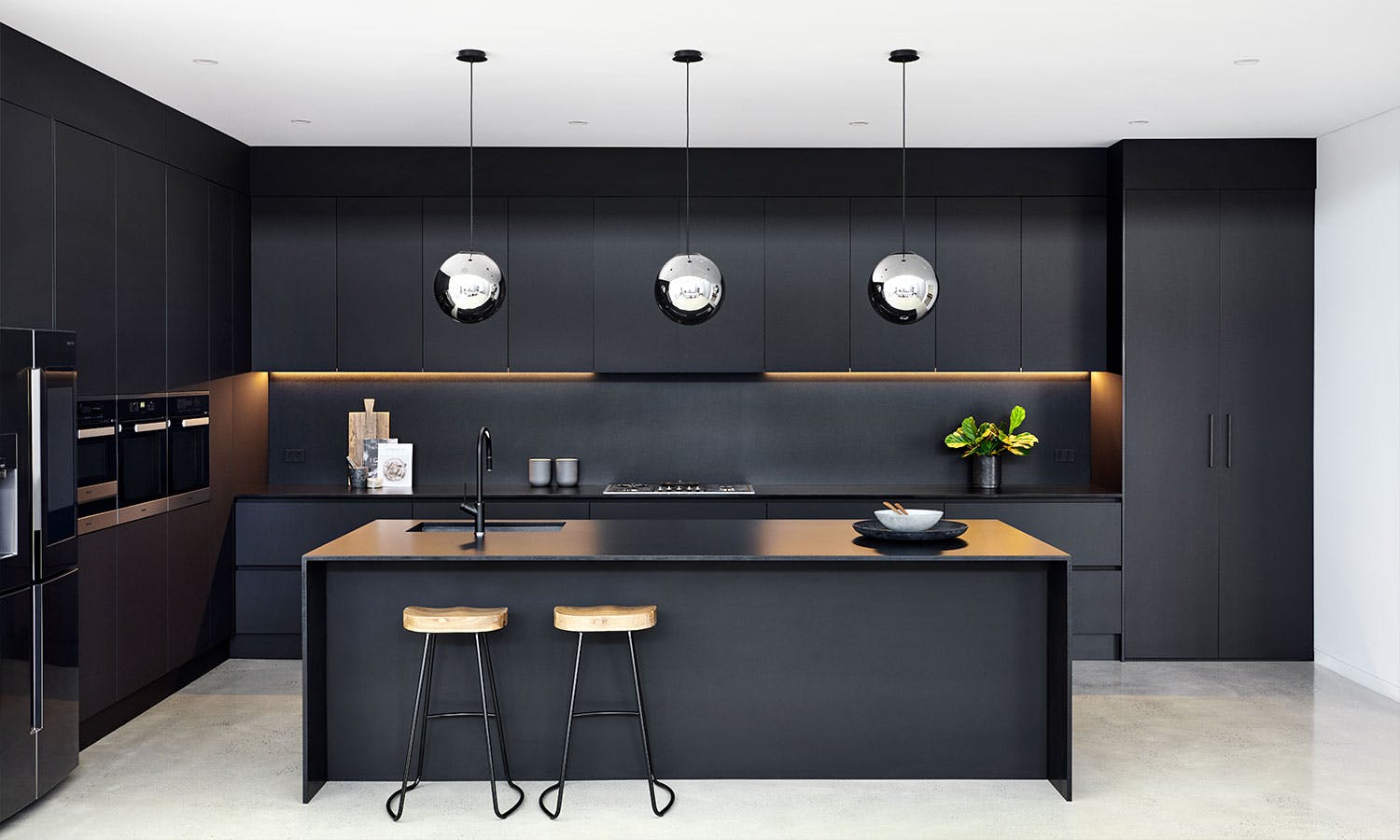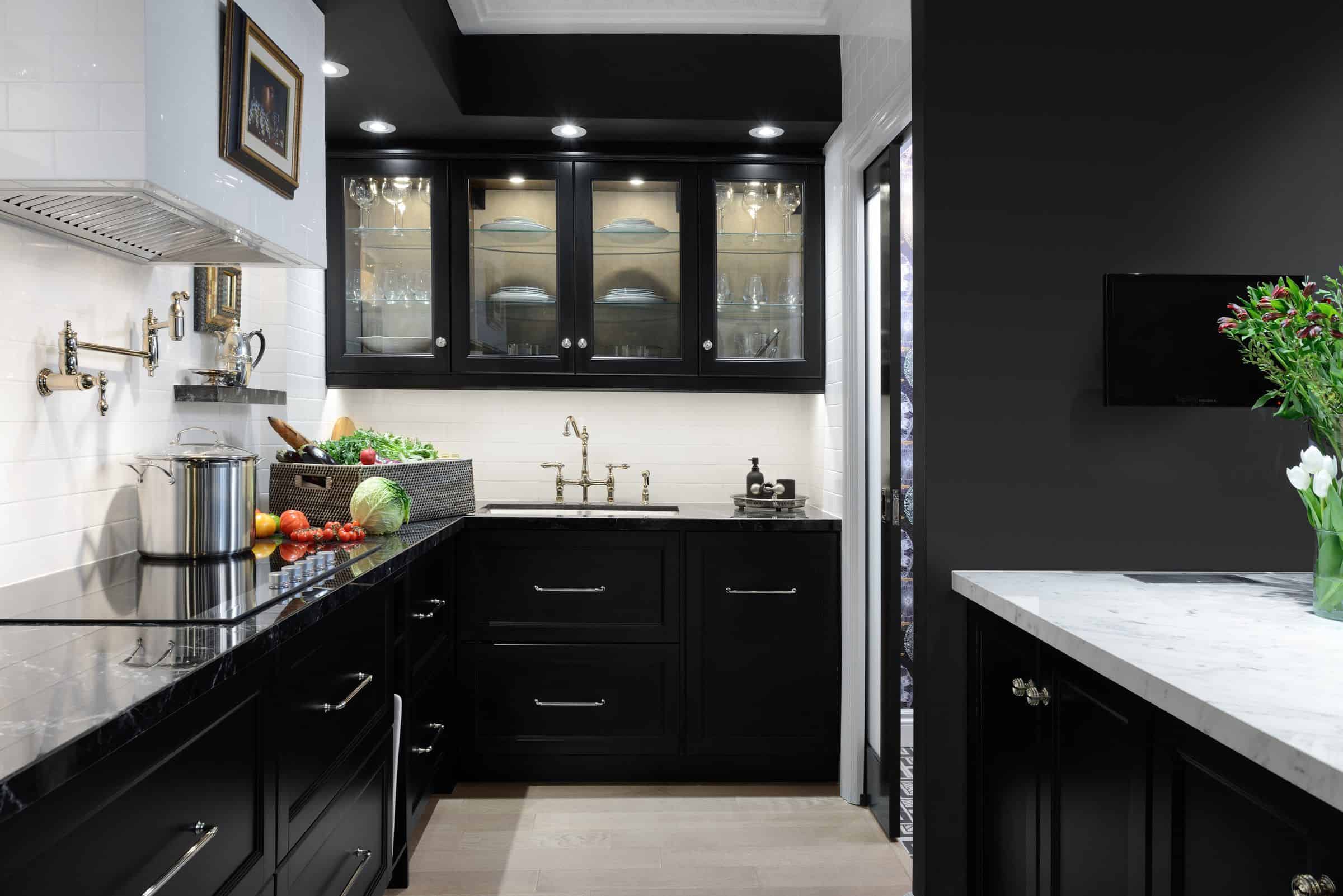Functionality and Layout

The drama of black cabinetry demands a kitchen design that is both strikingly beautiful and flawlessly functional. The deep, rich hue commands attention, and the layout must complement this boldness, ensuring a space that is as efficient as it is aesthetically stunning. The following explorations delve into the heart of this design challenge, showcasing how to orchestrate a kitchen where form and function dance in perfect harmony.
Modern kitchen black cabinets – Optimizing a black cabinet kitchen hinges on a thoughtful integration of layout, lighting, and appliance placement. Each element plays a crucial role in shaping the overall user experience, transforming a simple cooking space into a dynamic and inviting culinary haven.
Kitchen Layouts Incorporating Black Cabinets, Modern kitchen black cabinets
Three distinct kitchen layouts, each showcasing the versatility of black cabinets, are presented here. These designs prioritize workflow efficiency and maximize storage potential, showcasing the transformative power of careful planning.
First, consider the classic galley kitchen, reimagined with black cabinets. Tall, sleek upper cabinets stretch to the ceiling, maximizing vertical storage. Lower cabinets, also in black, feature a combination of deep drawers for utensils and pots, and standard door cabinets for plates and pantry items. A central island, clad in a contrasting light-colored material like quartz or marble, provides additional counter space and seating. This layout promotes a smooth, linear workflow, minimizing steps between prep, cooking, and cleaning zones.
Secondly, a U-shaped kitchen offers ample counter space and storage. Black cabinets line the three walls, creating a dramatic backdrop. A combination of base and wall cabinets, along with corner units designed for optimal space utilization (like lazy susans or pull-out shelves), ensures that every inch of storage is effectively used. The U-shape naturally creates distinct zones for cooking, cleaning, and food preparation, enhancing efficiency. A built-in breakfast bar, perhaps with black-framed pendant lights above, adds a touch of modern sophistication.
Finally, the L-shaped kitchen, particularly effective in open-plan living spaces, can be elegantly styled with black cabinets. One leg of the “L” houses the cooking range and oven, while the other features the sink and dishwasher. The corner can incorporate a clever storage solution, like a pull-out pantry or a carousel. This design allows for a smooth transition between different kitchen tasks, while still providing ample counter space. The open nature of the layout means the black cabinets become a stylish feature, accentuating the overall design aesthetic.
Lighting Strategies for Black Cabinets
The inherent darkness of black cabinets requires a deliberate lighting strategy to prevent the kitchen from feeling gloomy. Careful illumination transforms the cabinets into dramatic focal points, enhancing their sleek sophistication.
Layering light sources is paramount. Recessed lighting provides general illumination, while under-cabinet lighting illuminates countertops, eliminating shadows and making food preparation easier. Pendant lights above an island or breakfast bar add a touch of elegance and task lighting. Furthermore, strategically placed accent lighting can highlight the texture and depth of the cabinetry, showcasing their rich, dark tones. Consider LED strip lights inside glass-fronted cabinets to create a dramatic glow and showcase prized china or glassware. The interplay of these different light sources creates a dynamic and inviting atmosphere, preventing the black cabinets from overwhelming the space.
Essential Kitchen Appliance Placement
Five essential appliances and their ideal placement within a modern black cabinet kitchen are detailed below. The emphasis is on optimizing both functionality and visual appeal, ensuring a harmonious blend of practicality and style.
The placement of appliances significantly impacts workflow and aesthetics. Careful consideration of both factors ensures a kitchen that is both efficient and visually stunning.
- Refrigerator: Positioned discreetly near a wall, away from high-traffic areas, maintaining a seamless flow. Its stainless steel finish offers a subtle contrast against the black cabinets, preventing a visually heavy feel.
- Oven: Integrated into the black cabinetry, maintaining a cohesive and uncluttered look. Placement should be convenient for accessing frequently used cooking utensils and cookware.
- Dishwasher: Integrated within the black cabinetry, alongside the oven, to maintain a unified design. This keeps the appliance hidden, creating a clean and streamlined look.
- Microwave: Ideally placed above the oven or integrated into an upper cabinet, saving valuable counter space. This placement keeps the microwave out of sight, while still remaining easily accessible.
- Coffee Maker: Situated on the counter, ideally near the refrigerator, allowing for a convenient morning routine. A sleek, modern design in stainless steel or a matching black finish complements the cabinetry.
Materials and Maintenance: Modern Kitchen Black Cabinets

The allure of black kitchen cabinets lies in their dramatic sophistication, a bold statement that elevates any culinary space. However, this dramatic choice demands careful consideration of materials and a commitment to diligent maintenance. The longevity and aesthetic appeal of your black cabinets depend heavily on the material selected and the care you provide.
The spectrum of materials available for black kitchen cabinets is surprisingly diverse, each offering a unique blend of durability, cost, and maintenance requirements. From the rich warmth of wood to the sleek modernity of laminates, the decision hinges on your budget, desired aesthetic, and lifestyle.
Cabinet Material Options
Choosing the right material is paramount. The material will dictate not only the initial cost but also the long-term maintenance and lifespan of your cabinets. Let’s explore the leading contenders.
Wood: Solid wood cabinets, such as oak, cherry, or maple, offer unparalleled richness and elegance. The deep black stain accentuates the natural grain, creating a timeless look. However, solid wood requires more maintenance, is susceptible to scratches and water damage, and commands a higher price point. Regular polishing and sealing are essential to protect the finish and prevent discoloration. Examples include high-end kitchens featuring black-stained cherry wood, known for its luxurious appearance and durability when properly maintained. Alternatively, a less expensive but still aesthetically pleasing option could be black-stained oak, which is readily available and easier to work with.
Laminate: Laminate cabinets provide a cost-effective alternative to solid wood. They offer a wide range of finishes, including convincing black wood-grain effects. Laminates are highly durable, resistant to scratches and moisture, and relatively easy to clean. While not as luxurious as wood, they represent a practical and budget-friendly choice, especially for high-traffic kitchens. A high-quality laminate can mimic the look of expensive wood species, providing a sophisticated aesthetic without the hefty price tag. For example, many modern kitchens opt for black high-gloss laminate for its sleek, contemporary appeal and ease of maintenance.
Thermofoil: Thermofoil cabinets are constructed with a medium-density fiberboard (MDF) core wrapped in a vinyl film. This creates a smooth, durable surface that’s resistant to moisture and scratches. The black thermofoil finish is consistent and easy to clean, making it a popular choice for busy kitchens. The cost is generally moderate, falling between solid wood and laminate. This option offers a balance of affordability, durability, and a contemporary look. For instance, a modern minimalist kitchen might benefit from the clean lines and low-maintenance properties of black thermofoil cabinets.
Cleaning and Maintaining Black Kitchen Cabinets
Maintaining the pristine beauty of your black cabinets requires a dedicated approach. The specific cleaning method will vary depending on the material, but some general principles apply.
- Regular Dusting: Dust your cabinets weekly with a soft microfiber cloth or a feather duster. This prevents dust from accumulating and attracting grime.
- Gentle Cleaning: For more thorough cleaning, use a slightly damp (not soaking wet) microfiber cloth with a mild dish soap solution. Always test any cleaning solution on an inconspicuous area first.
- Targeted Spot Cleaning: Address spills and stains immediately to prevent them from setting. For stubborn stains, use a specialized cabinet cleaner appropriate for your cabinet material. Avoid abrasive cleaners or scouring pads, which can scratch the surface.
- Polish (for Wood): Wood cabinets benefit from occasional polishing with a wood-specific polish to maintain their luster and protect the finish. Follow the manufacturer’s instructions carefully.
- Protective Measures: Use cabinet protectors or liners to prevent scratches and damage from cookware and utensils.
Pros and Cons of Black Kitchen Cabinets
Weighing the advantages and disadvantages of black cabinets is crucial for an informed decision. The impact extends beyond aesthetics, encompassing practicality and long-term considerations.
| Feature | Pros | Cons | Considerations |
|---|---|---|---|
| Aesthetic Impact | Adds sophistication and drama; creates a modern, sleek look; visually grounding; versatile with various styles. | Can feel overwhelming in small spaces; shows fingerprints and smudges easily; may require more frequent cleaning. | Consider the overall kitchen size and lighting. |
| Durability | Many materials offer high durability (laminate, thermofoil); wood can be durable with proper care. | Wood is susceptible to scratches and water damage if not properly sealed and maintained. | Choose materials appropriate for your lifestyle and cleaning habits. |
| Maintenance | Relatively easy to clean for most materials; regular dusting is key. | Black shows imperfections more readily; more frequent cleaning needed compared to lighter colors. | Factor in time commitment for cleaning and maintenance. |
| Cost | Ranges widely depending on the material; laminate is generally most affordable; wood is most expensive. | Higher-end materials require higher upfront investment. | Budget accordingly and compare material costs. |
